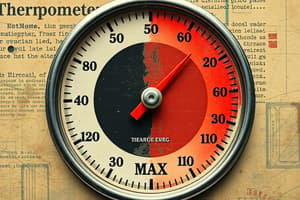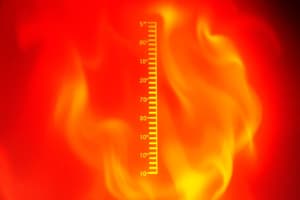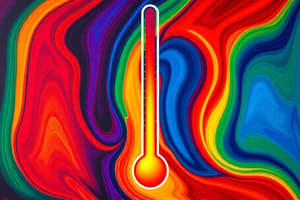Podcast
Questions and Answers
What does temperature primarily measure?
What does temperature primarily measure?
- Total energy of matter
- Volume of a substance
- Average kinetic energy of particles (correct)
- Potential energy of particles
Which unit is NOT commonly used to measure temperature?
Which unit is NOT commonly used to measure temperature?
- Newton (correct)
- Kelvin
- Fahrenheit
- Celsius
Which phase of matter typically has the highest kinetic energy?
Which phase of matter typically has the highest kinetic energy?
- Gas (correct)
- Liquid
- Solid
- Plasma
What is thermal energy the sum of?
What is thermal energy the sum of?
How do particles move in solids compared to gases?
How do particles move in solids compared to gases?
Which of the following best describes potential energy in a material?
Which of the following best describes potential energy in a material?
What is the most commonly used temperature scale worldwide?
What is the most commonly used temperature scale worldwide?
As the average distance between particles increases, what happens to their potential energy?
As the average distance between particles increases, what happens to their potential energy?
Flashcards are hidden until you start studying
Study Notes
Temperature and Thermal Energy
- Temperature represents how hot or cold an object is, reflecting the average kinetic energy of its particles.
- Kinetic energy refers to the energy of motion, determining how quickly particles in a substance move.
Units of Measurement
- Temperature is commonly measured using thermometers in three scales:
- Degrees Fahrenheit (°F)
- Degrees Celsius (°C)
- Degrees Kelvin (°K or K)
- The Celsius scale is most widely used globally for temperature measurement.
Phases of Matter and Kinetic Energy
- All matter consists of tiny particles in constant motion; the speed of this motion varies across different states:
- Solids: Particles vibrate slowly and are tightly packed.
- Liquids: Particles move faster and are less closely packed compared to solids.
- Gases: Particles move rapidly with significant distances between them.
- Higher temperatures correlate with increased average kinetic energy among particles.
Thermal Energy
- Thermal energy combines both kinetic and potential energy of the particles within a material.
- The potential energy of particles increases as the average distance between them increases, often occurring in gases compared to solids or liquids.
Understanding Differences
- Temperature is distinct from thermal energy; temperature measures the average kinetic energy, while thermal energy encompasses the sum of both kinetic and potential energy of all particles in a material.
Studying That Suits You
Use AI to generate personalized quizzes and flashcards to suit your learning preferences.




